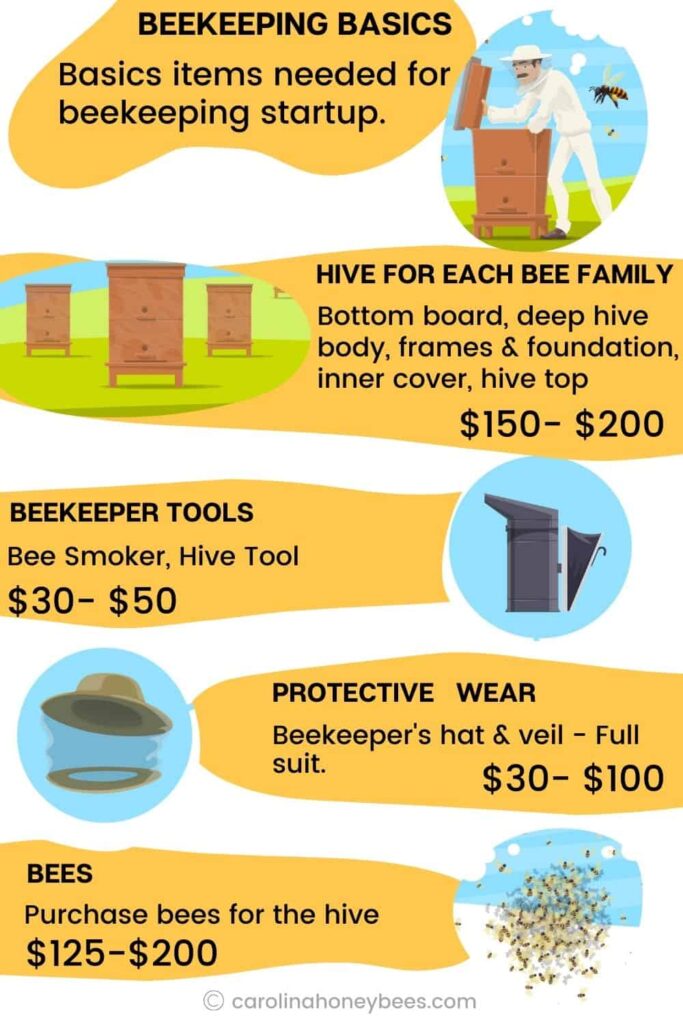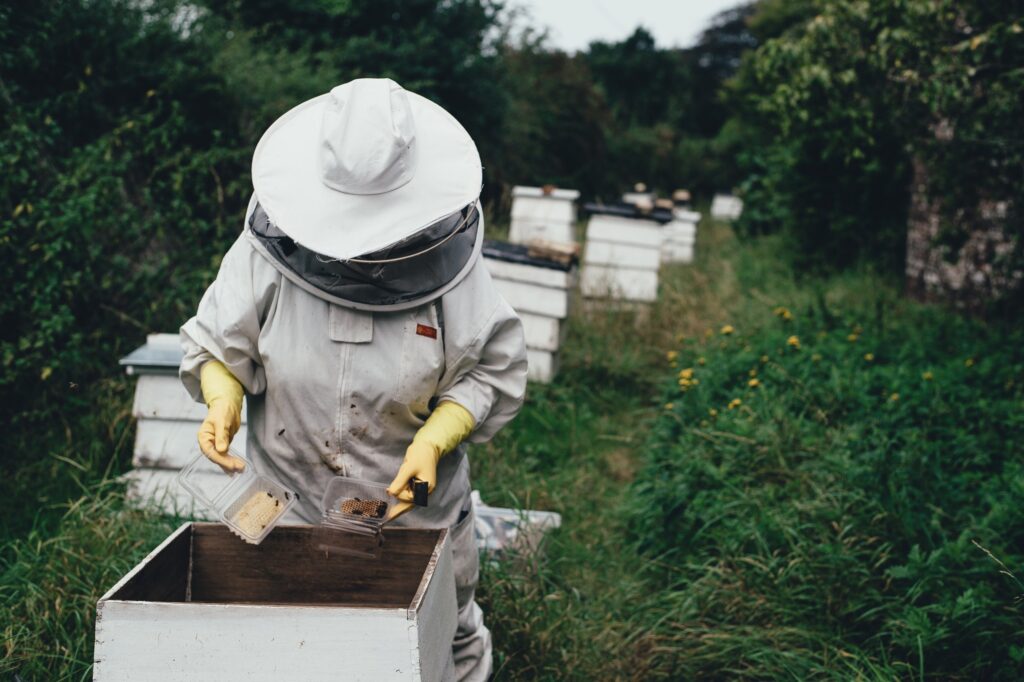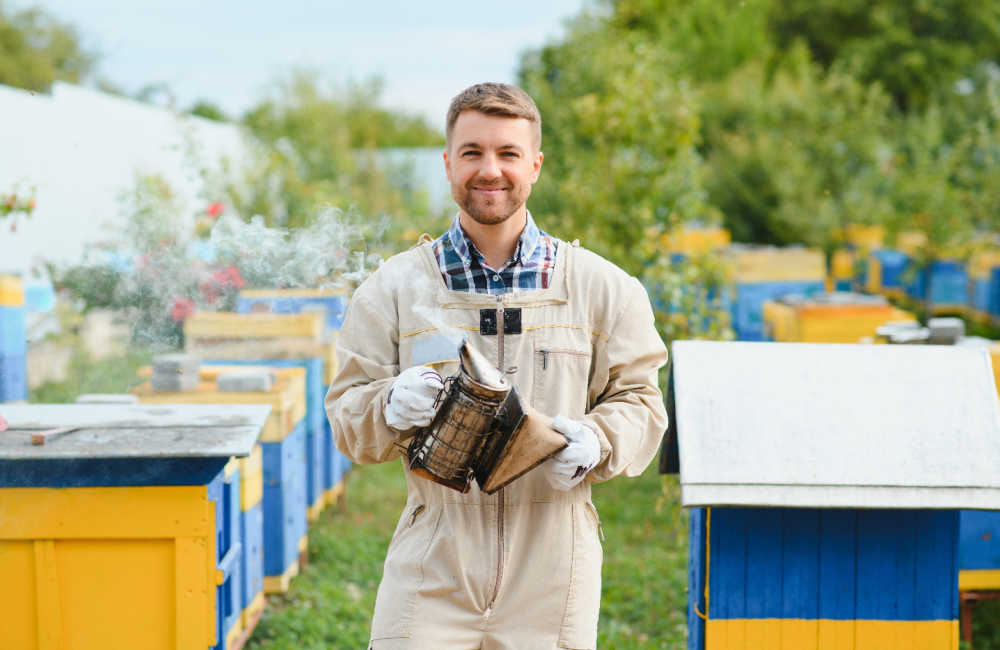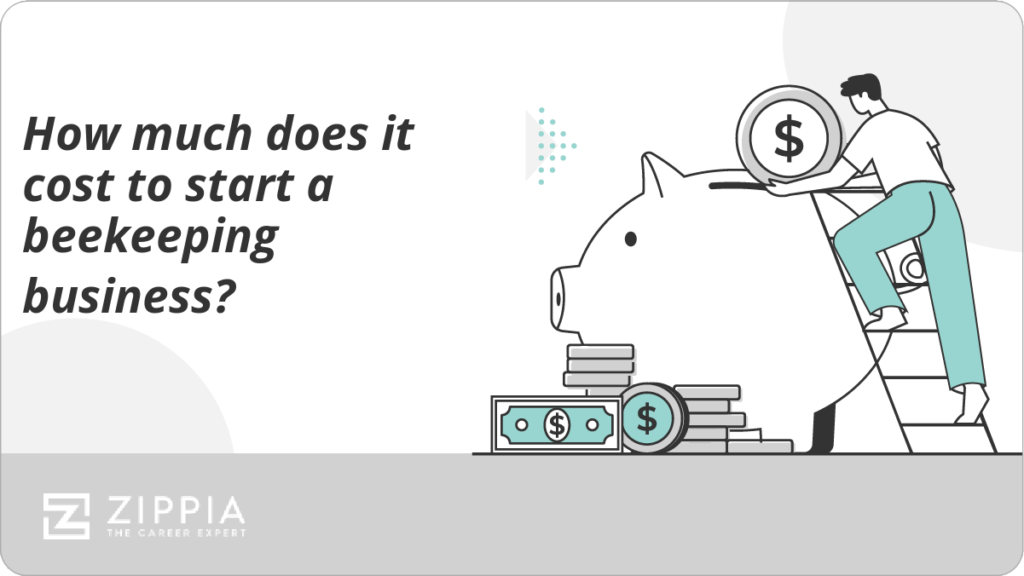
Are you curious about starting your own beekeeping adventure, but wondering about the financial aspect? In this article, we will explore the various expenses involved in starting beekeeping and provide you with a rough estimate of how much it might cost. From purchasing the necessary equipment and bee colonies to ongoing maintenance and unforeseen expenses, we’ll break down the costs so you can better plan and budget for your new buzzing hobby.
1. Equipment Costs
Starting out in beekeeping requires a set of essential equipment. Here are the main components you need to consider:
1.1. Hive Components
The heart of any beekeeping operation is the hive itself. You will need to invest in hive bodies, frames, and foundation sheets. Hive bodies act as the main structure for the bees, providing them with space to build their colony. Frames and foundation sheets go inside the hive bodies, providing support for the honeycomb. The number of hive components you need will depend on the size of your operation and the number of hives you plan to maintain.
1.2. Protective Gear
While working with bees, it is important to protect yourself from potential stings and bee aggression. Protective gear includes a beekeeping suit (typically made of a lightweight, breathable material), gloves, a veil, and boots. Remember, investing in good-quality protective gear is crucial to ensure your safety.
1.3. Tools and Accessories
Beekeeping requires a range of tools and accessories to manage and maintain your hives effectively. Some essential tools include a hive tool (used to pry open hive components), a smoker (to calm the bees during inspections), a bee brush (for gently moving bees away), and a bee feeder (used to provide supplemental food when needed). Additional tools and accessories may include a queen catcher, a honey extractor, a beekeeping knife, and a pollen trap.
1.4. Extracting Equipment
If you plan to harvest honey from your hives, you will need extracting equipment. This includes a honey extractor (either manual or electric), honey buckets or containers, honey filters, and bottling equipment. Extracting equipment can be a significant upfront investment, but it allows you to enjoy the fruits of your beekeeping labor.
2. Bee Costs
Acquiring bees is essential for starting a beekeeping enterprise. Here are the main costs associated with obtaining bees:
2.1. Bee Packages or Nucs
Bee packages are commonly used to introduce a new colony to your hive. They typically include a queen bee and a specific number of worker bees. Nucleus colonies, or nucs, on the other hand, are small, established colonies with a queen, worker bees, and a brood. The cost of bee packages or nucs will depend on the supplier, the number of bees included, and the time of year. Keep in mind that prices can vary between regions.
2.2. Queen Bees
Queen bees play a critical role in the success of your beekeeping venture. It is important to choose a reputable supplier for healthy and high-quality queen bees. The cost of queen bees depends on their genetics, breed, and availability.
2.3. Shipping or Pickup Fees
When purchasing bees or queen bees, you may need to consider additional costs such as shipping or pickup fees. These fees can vary depending on the distance to the supplier and the method of transportation. It is important to factor in these costs when planning your bee acquisition.

3. Educational Resources
To become a successful beekeeper, it is crucial to invest in educational resources to enhance your knowledge and skills. Here are some options to consider:
3.1. Beekeeping Courses
Taking a beekeeping course is a great way to learn the basics and gain hands-on experience. Look for local or online courses that cover topics such as hive management, bee biology, pest control, and honey production. The cost of beekeeping courses can range from affordable online options to more comprehensive in-person courses.
3.2. Books and Guides
Books and guides are valuable resources for beekeepers of all experience levels. They provide in-depth knowledge on various aspects of beekeeping, including hive maintenance, bee diseases, and honey extraction techniques. The cost of books and guides can vary, but there are many affordable options available.
3.3. Workshops and Seminars
Attending workshops and seminars hosted by experienced beekeepers or beekeeping associations can provide valuable insights and networking opportunities. These events often feature expert speakers who share their knowledge and experiences. The cost of workshops and seminars may vary depending on the duration and the expertise of the presenters.
4. Hive Location and Setup
Choosing the right location and setting up your hive properly are crucial for the success and productivity of your bees. Consider the following factors:
4.1. Land or Rental Costs
If you don’t have suitable land available, you may need to consider renting a space for your beehives. Rental costs will vary depending on the size of the area, the location, and local regulations. However, some beekeepers may be fortunate enough to have access to their own land, eliminating this expense.
4.2. Hive Stand or Platform
To ensure proper airflow and accessibility, your hives should be elevated off the ground. This can be done by using a hive stand or platform, which can be purchased or built. The cost of a hive stand or platform will depend on the materials used and whether you decide to build it yourself or purchase a pre-made option.
4.3. Hive Shelter
Providing shelter for your hives helps protect them from harsh weather conditions and extreme temperatures. This can be in the form of a simple roof or a more elaborate structure. The cost of hive shelter will depend on the materials used, the size of the shelter, and any additional features you choose to include.

5. Bee Food and Supplementation
To ensure healthy and productive colonies, bees may require supplemental feeding. Here are some common bee food and supplementation costs:
5.1. Sugar Syrup
Sugar syrup is a common form of supplemental feed for bees. It provides them with carbohydrates when natural nectar sources are scarce. The cost of sugar syrup depends on the quantity required and whether you choose to make it yourself or purchase pre-made syrup.
5.2. Pollen Patties
Pollen patties are another source of nutrition for bees. They contain protein and essential vitamins, aiding in brood development and overall colony health. Pollen patties can be purchased or made at home. The cost will depend on the quantity needed and the method of obtaining them.
5.3. Medication and Treatments
To maintain strong and healthy colonies, beekeepers often need to invest in medications and treatments for common bee diseases and pests. The cost of medication and treatments will depend on the specific products you choose and the size of your operation. It is important to consult with experienced beekeepers or professionals to determine the appropriate treatments for your specific situation.
6. Regulatory and Legal Expenses
Beekeeping may come with certain regulatory and legal requirements, which can vary depending on your location. Here are some potential expenses to consider:
6.1. Beekeeping Permit or License
Some regions may require beekeepers to obtain a permit or license to legally keep bees. The cost of obtaining a permit or license will depend on local regulations. Be sure to research and comply with any legal requirements in your area.
6.2. State or Local Regulations
In addition to permits or licenses, there may be other regulations you need to comply with, such as hive registration or regular inspections. Familiarize yourself with the specific regulations in your area to avoid any potential legal issues.
6.3. Liability Insurance
Beekeeping involves potential risks, such as bee stings or property damage. It is wise to consider liability insurance to protect yourself and your operation. The cost of liability insurance will depend on the coverage amount and the specific risks associated with your beekeeping activities.

7. Beehive Maintenance
Keeping your beehives in good condition is essential for the health and productivity of your colonies. Consider the following maintenance costs:
7.1. Hive Inspections
Regular inspections allow you to monitor the health of your bees, identify potential issues, and take necessary actions. This may involve equipment such as a beekeeping suit, gloves, a smoker, and other tools previously mentioned. Inspection frequency will vary and depends on the needs of your colonies.
7.2. Hive Cleaning
Maintaining clean hives helps prevent the spread of diseases and pests. This may involve cleaning and sterilizing hive components, replacing old frames, and ensuring proper sanitation practices. The cost of hive cleaning will depend on the cleaning materials used and any replacement items needed.
7.3. Replacing Old Equipment
Over time, hive components may need to be replaced due to wear and tear. Frames, foundation sheets, and other items may become damaged or less effective. It is important to budget for the replacement of old equipment to ensure the longevity and efficiency of your hives.
8. Overwintering Costs
Preparing your hives for the winter season is essential to help your bees survive and thrive. Consider the following costs associated with overwintering:
8.1. Insulation Materials
Insulating your hives can help regulate temperature and protect bees from extreme cold. Insulation materials can include foam insulation boards, hive wraps, and entrance reducers. The cost will depend on the size of your operation and the specific materials chosen.
8.2. Winter Feeding
During the winter, bees rely on stored food reserves to survive. If your colonies do not have enough honey stores, you may need to provide supplemental winter feeding. This can include sugar syrup or fondant. The cost will depend on the quantity of food needed and any additional supplements required.
8.3. Varroa Mite Control
Varroa mites can be a significant threat to bee colonies, especially during the winter when bees are vulnerable. Implementing varroa mite control measures, such as treatments or monitoring devices, is necessary to protect your bees. The cost of varroa mite control will depend on the specific methods chosen and the size of your operation.

9. Unexpected Expenses
Beekeeping, like any other agricultural venture, is prone to unexpected expenses. Here are some potential unforeseen costs to consider:
9.1. Swarm Management
Bee colonies have a natural tendency to swarm, which can lead to the loss of bees and potential damage. Investing in swarm management techniques and equipment, such as swarm traps or queen rearing tools, can help mitigate these risks. The cost will depend on the specific methods employed.
9.2. Emergency Equipment Replacement
Accidents happen, and certain equipment may need to be replaced unexpectedly. This can include damaged hive components, protective gear, or tools. It is important to have a contingency fund to cover any emergency equipment replacement costs that may arise.
9.3. Bee Diseases and Treatments
Despite your best efforts, bee colonies can be susceptible to diseases and pests. The cost of diagnosing, treating, and managing bee diseases can vary greatly depending on the specific issue. It is crucial to stay vigilant, learn about common bee diseases, and consult with professionals when needed.
10. Costs of Scaling Up
Once you have established a successful beekeeping operation, you may consider scaling up your business. Here are some costs to consider when expanding:
10.1. Additional Hive Equipment
Expanding your bee population may require additional hive components to accommodate the new colonies. This can include hive bodies, frames, and foundation sheets. The cost will depend on the number of new colonies and the specific equipment needed.
10.2. Expanding Bee Population
Acquiring more bees to expand your operation will come with additional costs. This can include purchasing bee packages, queen bees, or nucleus colonies. It is important to carefully consider the financial implications of expanding your bee population and ensure you have the necessary resources in place.
10.3. Training and Education
Expanding your beekeeping operation may require specialized training and education to manage larger colonies and handle the challenges that come with growth. Investing in advanced courses, workshops, or mentorship programs can help you develop the necessary skills and knowledge. The cost will depend on the specific training opportunities chosen.
Starting a beekeeping venture involves various costs, from equipment and bees to educational resources and unexpected expenses. It is important to carefully plan and budget for these costs to ensure a successful and sustainable beekeeping operation. Remember, beekeeping can be a rewarding and fulfilling hobby or business, and with proper financial preparation, you can embark on this journey with confidence.
